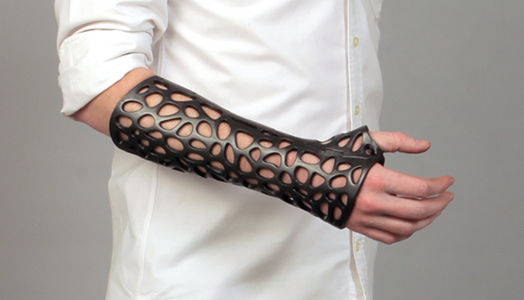IAnD Exclusive
Design Impact Special
Design Impact Special
By Beverly Pereira
Photography:Deniz Karasahin
 |
| . |
This
user-friendly 3D-printed medical cast could revolutionize the treatment of
broken bones...
The orthopaedic
plaster cast has been used for decades to heal broken bones. Besides being
heavy and bulky, its use comes with a slew of limitations including itchiness,
rashes and an unbearable odour. It seems like Turkish industrial designer Deniz
Karasahin of DK Design Studio might have just found a viable solution to these
issues.
.jpg) |
| Deniz Karasahin |
A four-month
study on the subject has led Deniz to develop a prototype of a medical cast
that aims to improve the whole experience of healing fractured bones.
.jpg) |
| . |
The design ‘Osteoid’
that has won the Golden A’Design award in the 3D Printed Forms and Product
Design category for 2013-2014, focuses on the patient’s comfort; for which the
patient’s limb is scanned via a 3D body scanner to create a 3D-printed cast
that fits to the tee.
.jpg) |
| . |
Deniz has
tackled the biggest challenge — a fully functional locking mechanism. For the
cast to be strong enough to protect, practical enough to be worn on the fragile
injured area, yet effective in the healing process without straying away from
the general form of a medical cast, the Osteoid is made from two detachable pieces,
fixed together with a flexible pin.
.jpg) |
| . |
The result is
a slimmer, lighter and water-resistant cast with a lattice pattern for ample
ventilation that does away with smells and itches. More importantly, the
Osteoid enhances the rate of bone healing through the use of low-intensity
pulse ultrasound (LIPUS).
While the
LIPUS system has been around for years, it has never been successfully
implemented since probes are required to be directly placed on the injured
area—a criteria not fulfilled by conventional casts.
.jpg) |
| . |
The Osteoid’s
design allows for this through attachable probes, also produced using a 3D
printer. Single 20-minute daily LIPUS sessions promise to reduce the healing
process up to 38% and increase the rate of healing up to 80% for non-union fractures,
or bones that fail to heal for three to six months.
The
user-friendly and aesthetically pleasing design of the Osteoid is currently in
the prototype stage, and is likely to become a medically viable option in the
near future.

it´s awesome!
ReplyDeletecool ....
ReplyDelete